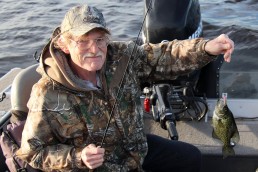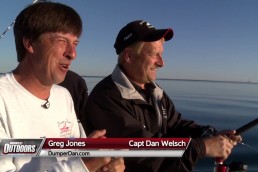Fishing Lake Mitchell
SHARE THIS POST
Bill McCarty and I love jig fishing for crappies and walleyes. Working a cabbage weed patch with jigs is pure delight. The biggest problem is finding a lake with good cabbage weeds. Fortunately, Cadillac and Mitchell have plenty of good cabbage weeds.
We caught crappies over 13 inches with one a shade under 14. A handful of jigs are all that you really need. A graph and a trolling motor come in handy. Using your mapping feature on your graph and color-coding the depths eliminates unproductive water.
Knowing that cabbage weeds grow out to maybe 10 feet of water, we coded the map to show this. Then it was a simple matter of searching out the edges where the two colors met. In addition numerous humps popped up offering small islands of isolated fishing.
Crappies and walleyes were working the outer edges of the cabbage, feeding on large shiners and minnows. At first light and lasting maybe two hours, you could see fish pushing minnows to the surface.
The 2-inch Charlie Brewer crappie grub brought fast hits from the feeding-frenzy crappies. Moving up to a 3-inch Brewer grub, the walleyes pounded it. We had crappies burping out 3- to 4-inch minnows into the livewell.
The water would boil where the active fish were pushing the baitfish. Edges of the weeds and the inside cups or turns were the best. You can’t get better or faster action on crappie or walleye than during a team massacre on minnows.
When the frenzy stopped, the game plan changed. A much slower approach was needed. On the crappies, we dropped down to a 1/32-ounce jig, and for the walleyes we used both a 1/32-ounce head and possibly a 1/8-ounce head.
The key was dropping it slowly on their noses and then creeping it back in. Our best fishing coincided directly to the position of the moon. When the moon was rising or setting, we enjoyed good fishing. Do I trust the moon phase? I set my vacation plans around a good moon phase. If the moon is rising or setting within 3 hours of sunrise, put me down.
Now our luck turned in our favor when the wind picked up. Put a chop on the water and the action resumed. I love a chop on the water and drifting. Most days we enjoyed or tolerated winds between 15 and 20 mph, when we needed drift socks.
The drift socks slowed us down where we could work the openings and the edges with success. With wind and a second rod, we added a float/bobber with a jig placed 4 feet down. This dead rod really works great with the wind. Lake Mitchell is a fish factory. Walleyes, crappies, pike and huge bluegills are there for the taking.
Fall pike fishing can be awesome on both Lake Cadillac and Lake Mitchell. With only a canal separating these two lakes, traversing back and forth is simple. “Tons of pike are caught each year from both lakes,” said Steve of Pilgrim Village on Lake Mitchell. Steve owns a resort and rents out a variety of cabins and homes on the water. Most of the pike run in the 22- to 26-inch range, but each season a few over 15 pounds are reported.
I can easily attest to the quality of fishing on this lake. It’s on my list each year as a must-fish location. Fall brings the best pike fishing, with limited pressure.
The best locations on Lake Cadillac start at the channel at the State Park and runs two-thirds of the way along the north shoreline beyond Laura Lee’s Landing on the north shoreline. The south shoreline is good for almost the same distance.
On the south shoreline, deeper depths running to 20 feet are common. But what many anglers are unaware of is that once you are maybe 300 yards from shore, the depth becomes much shallower.
Fish the center portion of the lake in the areas described for the best early-season action. Just keep on moving, looking for weeds and changes in the depth and bottom content.
One minute you might be in 5 or 7 feet of water, and then the next thing you will be in 10 to 15 feet of water. This lake has fabulous structure and offers great fishing for many species. Don’t be surprised if a nice walleye hits your lure because they are fairly common.
Every now and then I run into someone who shares a fondness for something I like. In this case it was John Cleveland, marketing manager for Eppinger Company. The Dardevle, Red Eye and Rex Spoon are part of this company. Pike fishing was the topic. In the fall, big pike roam the shallows and the edges of the cabbage weeds. On Lake Mitchell, finding the edges is super simple and extremely effective.
Are you enjoying this post?
You can be among the first to get the latest info on where to go, what to use and how to use it!
“I like shallow-water fishing, and that is why ice-out and fall turnover are my favorite times on the water,” said Cleveland. Fifty-degree water is the magical temperature. Starting in October the water temperature will drop, and once into the mid-50s, big pike put on the feedbag.
A prime location in the fall includes any green cabbage weeds. If you find green weeds, you will find pods of active pike. Some anglers like to troll and others, like John, will troll until the find a fish or good structure, and then cast.
Casting is like hand-to-hand contact. I love the feel of a nice pike ripping a spoon and the wild battle that they put on. Spoons are deadly baits and should be a huge part of your pike arsenal. Hands-down, the Dardevle spoon is my favorite.
The best spoon size for large pike is the 1-ounce spoon, which is about 4 inches long. Even a small pike will slam this large spoon. Second choice is the weedless Rex Spoon. The best color patterns: red and white with a copper back, 5 of diamonds with a brass back, gray ghost and the black spoon with a white stripe.
Most spoons come with a treble hook, but trust me, you will get a better hookset using a 2/0 or 3/0 single hook. Mustad and Eagle Claw both make a very nice hook for this application. Some anglers like to tip their spoons. I found that there are days where this really works, and days where it does not make a difference.
When I tip a spoon, I use a 4-inch Mister Twister tail. For some reason white is awesome, followed by black. White outdoes black 3 to 1. I do not worry about scent when targeting pike. The Rex spoon is a great spoon to run when fishing in and around any type of slop. It is snagless and will wobble thru the grass, around stumps and logs and through the thickest of weeds.
“Anglers need to become good spoon masters,” said Cleveland. Cast it out and let it flutter down before reeling. Reel and then stop for a few seconds. Cast it out and let in sink to the bottom and try jigging it back. Make the spoon work as a wounded or scared baitfish would react.
“Pike are hard on lures; therefore, you must keep your hooks sharp,” said Cleveland. Carry a small file, and after a few fish or if you banged into rocks or timber, touch them up with a few strokes. It makes a huge difference!
When you are not fishing, try hunting. Rolling hills filled with various trees, sprinkled with clearings, meadows and farmland await the hunter in Wexford County. The low areas feature nice swamps teaming with deer and bear. Grouse work the edges of the streams and swamps. In addition, there are plenty of great aspen stands and cut-over areas of various ages.
Snowshoe hares, ducks, geese and squirrels abound. There are wildlife sanctuaries near Mesick and Lake Cadillac that are closed to waterfowl hunting but provide great resting areas.
Much of the swampland is on the north and south end of the county. Huge blocks of public land are located between Cadillac and Hodenpyl Dam. I love swamp hunting. Deer hunting in a swamp or tight to the edge is exciting.
With a bit of boot time on the ground, you will locate runs entering and exiting a swamp. Follow the runways into the swamp using orange flag tape. Most often, going into the swamp 100 to 200 yards, you will find that many runways merge or come into close proximity of each other. Place you stand here. I shoot half of my deer sitting on the ground behind some natural cover in the swamp.
Give Wexford County a try this fall. There is plenty of fishing and a diverse population of animals and birds to pursue.
Become a MidWest Outdoors Insider here!
MWO
SHARE THIS POST
Did you enjoy this post?
You can be among the first to get the latest info on where to go, what to use and how to use it!
Jack Payne
Jack Payne is an accomplished angler and hunter who enjoys teaching others as much as learning from others. Seminar speaker, outdoor photography enthusiast, hunter safety instructor and volunteer at many events for both kids and adults as an instructor.


